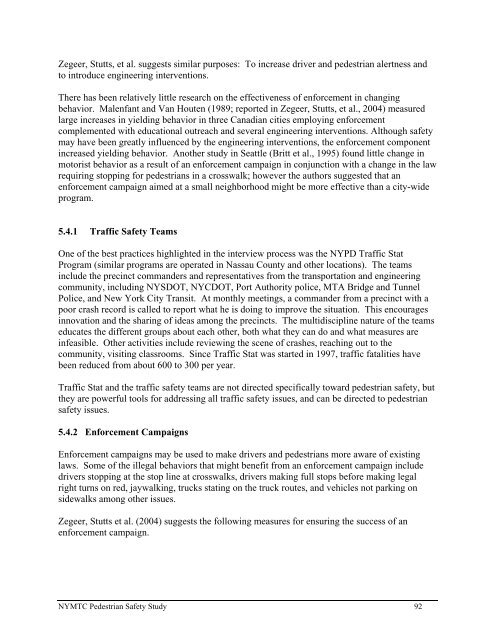NYMTC Regional Pedestrian Safety Study - New York Metropolitan ...
NYMTC Regional Pedestrian Safety Study - New York Metropolitan ...
NYMTC Regional Pedestrian Safety Study - New York Metropolitan ...
Create successful ePaper yourself
Turn your PDF publications into a flip-book with our unique Google optimized e-Paper software.
Zegeer, Stutts, et al. suggests similar purposes: To increase driver and pedestrian alertness and<br />
to introduce engineering interventions.<br />
There has been relatively little research on the effectiveness of enforcement in changing<br />
behavior. Malenfant and Van Houten (1989; reported in Zegeer, Stutts, et al., 2004) measured<br />
large increases in yielding behavior in three Canadian cities employing enforcement<br />
complemented with educational outreach and several engineering interventions. Although safety<br />
may have been greatly influenced by the engineering interventions, the enforcement component<br />
increased yielding behavior. Another study in Seattle (Britt et al., 1995) found little change in<br />
motorist behavior as a result of an enforcement campaign in conjunction with a change in the law<br />
requiring stopping for pedestrians in a crosswalk; however the authors suggested that an<br />
enforcement campaign aimed at a small neighborhood might be more effective than a city-wide<br />
program.<br />
5.4.1 Traffic <strong>Safety</strong> Teams<br />
One of the best practices highlighted in the interview process was the NYPD Traffic Stat<br />
Program (similar programs are operated in Nassau County and other locations). The teams<br />
include the precinct commanders and representatives from the transportation and engineering<br />
community, including NYSDOT, NYCDOT, Port Authority police, MTA Bridge and Tunnel<br />
Police, and <strong>New</strong> <strong>York</strong> City Transit. At monthly meetings, a commander from a precinct with a<br />
poor crash record is called to report what he is doing to improve the situation. This encourages<br />
innovation and the sharing of ideas among the precincts. The multidiscipline nature of the teams<br />
educates the different groups about each other, both what they can do and what measures are<br />
infeasible. Other activities include reviewing the scene of crashes, reaching out to the<br />
community, visiting classrooms. Since Traffic Stat was started in 1997, traffic fatalities have<br />
been reduced from about 600 to 300 per year.<br />
Traffic Stat and the traffic safety teams are not directed specifically toward pedestrian safety, but<br />
they are powerful tools for addressing all traffic safety issues, and can be directed to pedestrian<br />
safety issues.<br />
5.4.2 Enforcement Campaigns<br />
Enforcement campaigns may be used to make drivers and pedestrians more aware of existing<br />
laws. Some of the illegal behaviors that might benefit from an enforcement campaign include<br />
drivers stopping at the stop line at crosswalks, drivers making full stops before making legal<br />
right turns on red, jaywalking, trucks stating on the truck routes, and vehicles not parking on<br />
sidewalks among other issues.<br />
Zegeer, Stutts et al. (2004) suggests the following measures for ensuring the success of an<br />
enforcement campaign.<br />
<strong>NYMTC</strong> <strong>Pedestrian</strong> <strong>Safety</strong> <strong>Study</strong> 92
















